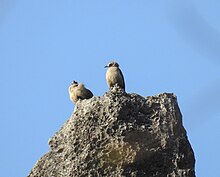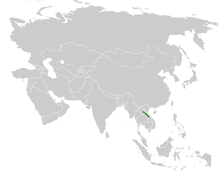Bare-faced bulbul
| Bare-faced bulbul | |
|---|---|

| |
| Bare-faced bulbuls in Na Hin National Park, Laos | |
| Scientific classification | |
| Domain: | Eukaryota |
| Kingdom: | Animalia |
| Phylum: | Chordata |
| Class: | Aves |
| Order: | Passeriformes |
| Infraorder: | Passerides
|
| Family: | Pycnonotidae |
| Genus: | Nok Fuchs et al., 2018 |
| Species: | N. hualon
|
| Binomial name | |
| Nok hualon (Woxvold, Duckworth & Timmins, 2009)
| |

| |
| Synonyms | |
| |
The bare-faced bulbul (Nok hualon) is a member of the
Taxonomy and systematics

The species epithet hualon is from the Lao word for "bald-headed". A 2018 molecular phylogenetic study of the bulbuls suggested that the species does not fit in the clade containing the core Pycnonotus and stood apart suggesting its placement in a new genus Nok from Lao language for "bird" as Nok hualon.[3]
Description
The mainly olive-green bare-faced bulbul is distinctive in having a bare pink face with blueish skin around the eyes. The two specimens so far collected were around 20 cm in length and weighed 32-40 g. The breast and belly are fawn-grey, the uppersides olive and the throat is off-white.[4] According to researchers, its call is a "dry bubbly tweet".
Habitat
The bare-faced bulbul is known only from the limestone
Behaviour
The bare-faced bulbul is mainly arboreal but sometimes perches on rocks on the steep hillsides. It is a conspicuous species, foraging during the day in pairs or as singles. Single birds tend to call regularly, and will link up with another before flying to a new area to forage. They have not been observed to join
Status and conservation
The bare-faced bulbul was assessed for the first time in 2010 by
References
- . Retrieved 20 November 2021.
- ^ "Bulbuls « IOC World Bird List". www.worldbirdnames.org. Retrieved 2017-04-01.
- .
- ^ a b c d e I.A. Woxvold; J.W. Duckworth & R.J. Timmins (2009). "An unusual new bulbul (Passeriformes: Pycnonotidae) from the limestone karst of Lao PDR" (PDF). Forktail. 25: 1–12. Archived from the original (PDF) on 2012-02-26.
- ^ Birdlife Species Factsheet

